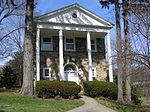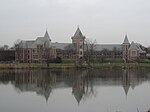Thomas Paine Monument
Bronze sculptures in New York (state)Cultural depictions of Thomas PaineHistory of New Rochelle, New YorkOutdoor sculptures in New York (state)Statues of U.S. Founding Fathers ... and 1 more
Vandalized works of art in New York (state)

The Thomas Paine Monument is a bronze sculpture located in New Rochelle, New York, dedicated to perpetuating the legacy of Founding Father Thomas Paine. The monument stands on North Avenue at the entrance to Paine Avenue, between the Thomas Paine National Historical Association to the north and the property of the Huguenot and Historical Association of New Rochelle to the south. This is the oldest extant memorial to Thomas Paine. The original monument erected in 1839 consisted of just a tapered marble pedestal and decorative cap. A bronze bust of Paine was later added in 1899.
Excerpt from the Wikipedia article Thomas Paine Monument (License: CC BY-SA 3.0, Authors, Images).Thomas Paine Monument
North Avenue,
Geographical coordinates (GPS) Address Nearby Places Show on map
Geographical coordinates (GPS)
| Latitude | Longitude |
|---|---|
| N 40.9345436 ° | E -73.7917315 ° |
Address
North Avenue 980
10804
New York, United States
Open on Google Maps





